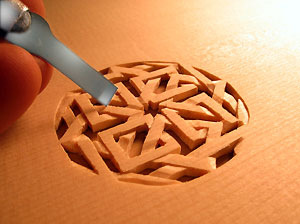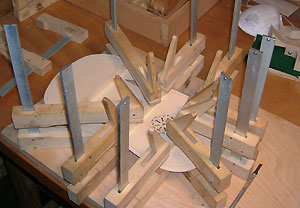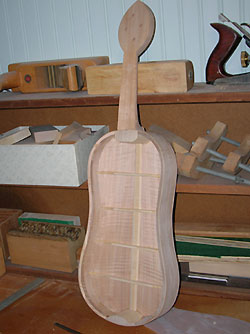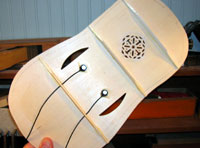|
 The fiddle that I built here is a very late Medieval or early Renaissance model. It is glued up from separate ribs and back and neck. Early Medieval fiddles had a neck, body, and pegbox that was carved from a solid block of wood. Also called the vielle, the fiddle was one of the most common instruments in the Middle Ages. Images of vielles are everywhere in medieval artwork. The bridges on early vielles were lower than later instruments and the bodies varied in size and shape. Some bowed instruments, like the rebec, had narrow bodies with a shrill sound. A wider body gives a more mellow sound. Raising the bridge increased the downward-bearing string tension on the bridge and, combined with a thinner soundboard, increased the volume of the vielle. The soundpost and bassbar were later Renaissance inventions. Inclusion of these features in a reconstruction of a transitional vielle will result in an instrument with a sound that the late medieval musician was unfamiliar with. Since our main interest is constructing the fiddle the way it was built in a given era and then finding out what can be done with it using music from that era, such anachronistic features are a really bad idea. The fiddle that I built here is a very late Medieval or early Renaissance model. It is glued up from separate ribs and back and neck. Early Medieval fiddles had a neck, body, and pegbox that was carved from a solid block of wood. Also called the vielle, the fiddle was one of the most common instruments in the Middle Ages. Images of vielles are everywhere in medieval artwork. The bridges on early vielles were lower than later instruments and the bodies varied in size and shape. Some bowed instruments, like the rebec, had narrow bodies with a shrill sound. A wider body gives a more mellow sound. Raising the bridge increased the downward-bearing string tension on the bridge and, combined with a thinner soundboard, increased the volume of the vielle. The soundpost and bassbar were later Renaissance inventions. Inclusion of these features in a reconstruction of a transitional vielle will result in an instrument with a sound that the late medieval musician was unfamiliar with. Since our main interest is constructing the fiddle the way it was built in a given era and then finding out what can be done with it using music from that era, such anachronistic features are a really bad idea.
  The neck and pegbox are carved from a single piece of maple and attached to the body with a wood screw. Early violin (including Strads) and lute necks were attached with nails. A slot mortise and tenon joint like a modern violin would simply be anachronistic. The neck and pegbox are carved from a single piece of maple and attached to the body with a wood screw. Early violin (including Strads) and lute necks were attached with nails. A slot mortise and tenon joint like a modern violin would simply be anachronistic.
The pegs were made to echo the shape of the pegbox.
 A litle rosette with four-fold symmetry is carved into the top of the vielle. After carving the perforations, a small chisel is used to create the over-under effect. Rossettes of Arabic origin normally had six or eight-fold symmetry, like a lute rosette. A rosette with four-fold symmetry is more characteristic of a gothic design. A litle rosette with four-fold symmetry is carved into the top of the vielle. After carving the perforations, a small chisel is used to create the over-under effect. Rossettes of Arabic origin normally had six or eight-fold symmetry, like a lute rosette. A rosette with four-fold symmetry is more characteristic of a gothic design.
 The top is a flat plate glued over arched braces. This is similar to the construction of early Renaissance viols. Arched tops carved from solid were a later development. Without a soundpost and bassbar, and with a lower bridge, the volume of Medieval fiddles would be less than a Renaissance fiddle and much, much less than a violin. This was appropriate for the music and the performance practice of the time, when the instruments were not played in large groups. In the Renaissance, instruments were built in families and consort playing became the fashion. The top is a flat plate glued over arched braces. This is similar to the construction of early Renaissance viols. Arched tops carved from solid were a later development. Without a soundpost and bassbar, and with a lower bridge, the volume of Medieval fiddles would be less than a Renaissance fiddle and much, much less than a violin. This was appropriate for the music and the performance practice of the time, when the instruments were not played in large groups. In the Renaissance, instruments were built in families and consort playing became the fashion.
 The Renaissance style fiddle, made from thinner ribs and back, was much lighter than the Medieval style fiddle, carved from a solid block. The time periods of these instruments would necessarily overlap. There is evidence to suggest that the changes in instrument making that occurred in Medieval Europe did not occur in England until a hundred years later. There are cultures in Eastern Europe that still build and play rebecs more or less the way they were built and played in the Middle Ages. The Renaissance style fiddle, made from thinner ribs and back, was much lighter than the Medieval style fiddle, carved from a solid block. The time periods of these instruments would necessarily overlap. There is evidence to suggest that the changes in instrument making that occurred in Medieval Europe did not occur in England until a hundred years later. There are cultures in Eastern Europe that still build and play rebecs more or less the way they were built and played in the Middle Ages.
The number of hairs in a medieval bow was usually considerably less than a modern bow. This would result in a lower bow tension which suggests that the string tension was probably also lower than on a modern violin. The tensile strength of gut strings and the breaking point at different diameters, compared to modern strings, also suggests a lower tension. I use black horse hair instead of the white hair that is used in modern bows. Black hair is courser and bites into the strings a little more aggressively. This fiddle will have all gut strings, just like my lutes, rebec, and baroque guitars.
 Here's something genuinely ironic: Sometimes I build instruments as historically accurate as possible, with animal gut strings and horse glue, and then I put pick-ups in them. If we're playing in a noisy bar and we want to be heard above the din, we can crank up the volume of our lute, rebec or vielle and make it compete effectively with a noisy audience. If we are invited to play for a music history class in a University or a similar academic environment, we just unplug the instruments and we're back to the subtle sounds of original instruments. Here's something genuinely ironic: Sometimes I build instruments as historically accurate as possible, with animal gut strings and horse glue, and then I put pick-ups in them. If we're playing in a noisy bar and we want to be heard above the din, we can crank up the volume of our lute, rebec or vielle and make it compete effectively with a noisy audience. If we are invited to play for a music history class in a University or a similar academic environment, we just unplug the instruments and we're back to the subtle sounds of original instruments.
 Instruments without pickups and amplification require historically inaccurate modifications to make them louder--higher tension nylon strings, wound string basses, higher tension bows, soundposts, etc. Sticking a little piezo-electric transducer about the size of a dime to the underside of a soundboard in no way effects the tonal characteristics of the instrument and seems like a better way to accommodate a variety of venues than building historically inaccurate instruments. Instruments without pickups and amplification require historically inaccurate modifications to make them louder--higher tension nylon strings, wound string basses, higher tension bows, soundposts, etc. Sticking a little piezo-electric transducer about the size of a dime to the underside of a soundboard in no way effects the tonal characteristics of the instrument and seems like a better way to accommodate a variety of venues than building historically inaccurate instruments.
You could also just play into a microphone, but having a built-in pickup is really convenient, as anyone who has ever played in a crowded tavern can tell you.
Postscript: I have since added a soundpost to this vielle. The main reason was to prevent the top from caving in. It seems to me that medieval and Renaissance craftsmen would have solved this problem in the simplest and most direct manner--if the soundboard started collapsing you just jam a short stick underneath. The effect of such an addition is dramatic--a big increase in volume. Maybe this is how the violin soundpost was originally invented!
| 

 The fiddle that I built here is a very late Medieval or early Renaissance model. It is glued up from separate ribs and back and neck. Early Medieval fiddles had a neck, body, and pegbox that was carved from a solid block of wood. Also called the vielle, the fiddle was one of the most common instruments in the Middle Ages. Images of vielles are everywhere in medieval artwork. The bridges on early vielles were lower than later instruments and the bodies varied in size and shape. Some bowed instruments, like the rebec, had narrow bodies with a shrill sound. A wider body gives a more mellow sound. Raising the bridge increased the downward-bearing string tension on the bridge and, combined with a thinner soundboard, increased the volume of the vielle. The soundpost and bassbar were later Renaissance inventions. Inclusion of these features in a reconstruction of a transitional vielle will result in an instrument with a sound that the late medieval musician was unfamiliar with. Since our main interest is constructing the fiddle the way it was built in a given era and then finding out what can be done with it using music from that era, such anachronistic features are a really bad idea.
The fiddle that I built here is a very late Medieval or early Renaissance model. It is glued up from separate ribs and back and neck. Early Medieval fiddles had a neck, body, and pegbox that was carved from a solid block of wood. Also called the vielle, the fiddle was one of the most common instruments in the Middle Ages. Images of vielles are everywhere in medieval artwork. The bridges on early vielles were lower than later instruments and the bodies varied in size and shape. Some bowed instruments, like the rebec, had narrow bodies with a shrill sound. A wider body gives a more mellow sound. Raising the bridge increased the downward-bearing string tension on the bridge and, combined with a thinner soundboard, increased the volume of the vielle. The soundpost and bassbar were later Renaissance inventions. Inclusion of these features in a reconstruction of a transitional vielle will result in an instrument with a sound that the late medieval musician was unfamiliar with. Since our main interest is constructing the fiddle the way it was built in a given era and then finding out what can be done with it using music from that era, such anachronistic features are a really bad idea. 
 The neck and pegbox are carved from a single piece of maple and attached to the body with a wood screw. Early violin (including Strads) and lute necks were attached with nails. A slot mortise and tenon joint like a modern violin would simply be anachronistic.
The neck and pegbox are carved from a single piece of maple and attached to the body with a wood screw. Early violin (including Strads) and lute necks were attached with nails. A slot mortise and tenon joint like a modern violin would simply be anachronistic. A litle rosette with four-fold symmetry is carved into the top of the vielle. After carving the perforations, a small chisel is used to create the over-under effect. Rossettes of Arabic origin normally had six or eight-fold symmetry, like a lute rosette. A rosette with four-fold symmetry is more characteristic of a gothic design.
A litle rosette with four-fold symmetry is carved into the top of the vielle. After carving the perforations, a small chisel is used to create the over-under effect. Rossettes of Arabic origin normally had six or eight-fold symmetry, like a lute rosette. A rosette with four-fold symmetry is more characteristic of a gothic design. The top is a flat plate glued over arched braces. This is similar to the construction of early Renaissance viols. Arched tops carved from solid were a later development. Without a soundpost and bassbar, and with a lower bridge, the volume of Medieval fiddles would be less than a Renaissance fiddle and much, much less than a violin. This was appropriate for the music and the performance practice of the time, when the instruments were not played in large groups. In the Renaissance, instruments were built in families and consort playing became the fashion.
The top is a flat plate glued over arched braces. This is similar to the construction of early Renaissance viols. Arched tops carved from solid were a later development. Without a soundpost and bassbar, and with a lower bridge, the volume of Medieval fiddles would be less than a Renaissance fiddle and much, much less than a violin. This was appropriate for the music and the performance practice of the time, when the instruments were not played in large groups. In the Renaissance, instruments were built in families and consort playing became the fashion. The Renaissance style fiddle, made from thinner ribs and back, was much lighter than the Medieval style fiddle, carved from a solid block. The time periods of these instruments would necessarily overlap. There is evidence to suggest that the changes in instrument making that occurred in Medieval Europe did not occur in England until a hundred years later. There are cultures in Eastern Europe that still build and play rebecs more or less the way they were built and played in the Middle Ages.
The Renaissance style fiddle, made from thinner ribs and back, was much lighter than the Medieval style fiddle, carved from a solid block. The time periods of these instruments would necessarily overlap. There is evidence to suggest that the changes in instrument making that occurred in Medieval Europe did not occur in England until a hundred years later. There are cultures in Eastern Europe that still build and play rebecs more or less the way they were built and played in the Middle Ages.  Here's something genuinely ironic: Sometimes I build instruments as historically accurate as possible, with animal gut strings and horse glue, and then I put pick-ups in them. If we're playing in a noisy bar and we want to be heard above the din, we can crank up the volume of our lute, rebec or vielle and make it compete effectively with a noisy audience. If we are invited to play for a music history class in a University or a similar academic environment, we just unplug the instruments and we're back to the subtle sounds of original instruments.
Here's something genuinely ironic: Sometimes I build instruments as historically accurate as possible, with animal gut strings and horse glue, and then I put pick-ups in them. If we're playing in a noisy bar and we want to be heard above the din, we can crank up the volume of our lute, rebec or vielle and make it compete effectively with a noisy audience. If we are invited to play for a music history class in a University or a similar academic environment, we just unplug the instruments and we're back to the subtle sounds of original instruments. Instruments without pickups and amplification require historically inaccurate modifications to make them louder--higher tension nylon strings, wound string basses, higher tension bows, soundposts, etc. Sticking a little piezo-electric transducer about the size of a dime to the underside of a soundboard in no way effects the tonal characteristics of the instrument and seems like a better way to accommodate a variety of venues than building historically inaccurate instruments.
Instruments without pickups and amplification require historically inaccurate modifications to make them louder--higher tension nylon strings, wound string basses, higher tension bows, soundposts, etc. Sticking a little piezo-electric transducer about the size of a dime to the underside of a soundboard in no way effects the tonal characteristics of the instrument and seems like a better way to accommodate a variety of venues than building historically inaccurate instruments.